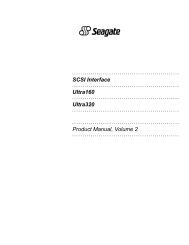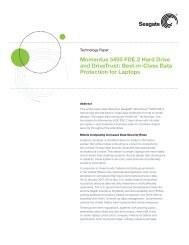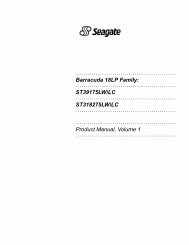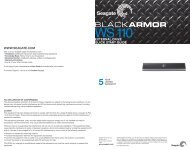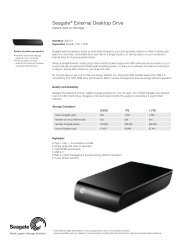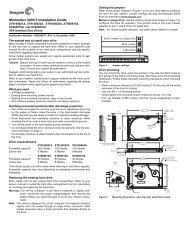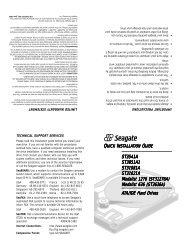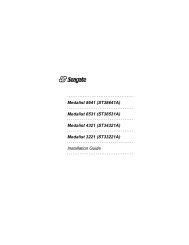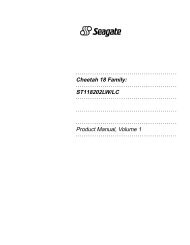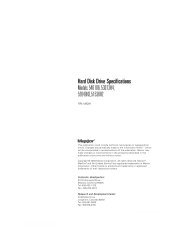Quickview 300 Product Manual PATA - Seagate
Quickview 300 Product Manual PATA - Seagate
Quickview 300 Product Manual PATA - Seagate
Create successful ePaper yourself
Turn your PDF publications into a flip-book with our unique Google optimized e-Paper software.
Glossary<br />
MTTR – Mean Time To Repair. The<br />
average time it takes to repair a drive that has<br />
failed for some reason. This only takes into<br />
consideration the changing of the major<br />
sub-assemblies such as circuit board or sealed<br />
housing. Component level repair is not<br />
included in this number as this type of repair<br />
is not performed in the field.<br />
O<br />
OVERHEAD – The processing time of a<br />
command by the controller, host adapter or<br />
drive prior to any actual disk accesses taking<br />
place.<br />
OVERWRITE – To write data on top of<br />
existing data, erasing it.<br />
OXIDE – A metal-oxygen compound. Most<br />
magnetic coatings are combinations of iron or<br />
other metal oxides, and the term has become<br />
a general one for the magnetic coating on tape<br />
or disk.<br />
P<br />
PARTITION – A portion of a hard disk<br />
devoted to a particular operating system and<br />
accessed as one logical volume by the system.<br />
PERFORMANCE – A measure of the speed<br />
of the drive during normal operation. Factors<br />
affecting performance are seek times, transfer<br />
rate and command overhead.<br />
PERIPHERAL – A device added to a system<br />
as an enhancement to the basic CPU, such as<br />
a disk drive, tape drive or printer.<br />
PHYSICAL FORMAT – The actual<br />
physical layout of cylinders, tracks, and sectors<br />
on a disk drive.<br />
PLATED MEDIA – Disks that are covered<br />
with a hard metal alloy instead of an<br />
iron-oxide compound. Plated disks can store<br />
greater amounts of data in the same area as a<br />
coated disk.<br />
PLATTER – An disk made of metal (or<br />
other rigid material) that is mounted inside a<br />
fixed disk drive. Most drives use more than<br />
one platter mounted on a single spindle (shaft)<br />
to provide more data storage surfaces in a<br />
small package. The platter is coated with a<br />
magnetic material that is used to store data as<br />
transitions of magnetic polarity.<br />
POH – Acronym for power on hours. The unit<br />
of measurement for Mean Time Between<br />
Failure as expressed in the number of hours<br />
that power is applied to the device regardless<br />
of the amount of actual data transfer usage.<br />
See MTBF.<br />
POSITIONER – See actuator.<br />
R<br />
RAM – Acronym for random access memory.<br />
An integrated circuit memory chip which<br />
allows information to be stored and retrieved<br />
by a microprocessor or controller. The<br />
information may be stored and retrieved in<br />
any order desired, and the address of one<br />
storage location is as readily accessible as any<br />
other.<br />
RAM DISK – A “phantom disk drive” for<br />
which a section of system memory (RAM) is<br />
set aside to hold data, just as if it were a<br />
number of disk sectors. The access to this data<br />
is extremely fast but is lost when the system is<br />
reset or turned off.<br />
READ AFTER WRITE – A mode of<br />
operation that has the computer read back<br />
each sector on the disk, checking that the data<br />
read back is the same as recorded. This slows<br />
disk operations, but raises reliability.<br />
READ VERIFY – A disk mode where the<br />
disk reads in data to the controller, but the<br />
controller only checks for errors and does not<br />
pass the data on to the system.<br />
READ/WRITE HEAD – The tiny<br />
electromagnetic coil and metal pole piece<br />
used to create and read back the magnetic<br />
patterns (write or read information) on the<br />
disk. Each side of each platter has its own<br />
read/write head.<br />
G-6 <strong>Quickview</strong> <strong>300</strong> 80/100/120/160/200/250/<strong>300</strong>GB <strong>PATA</strong>



